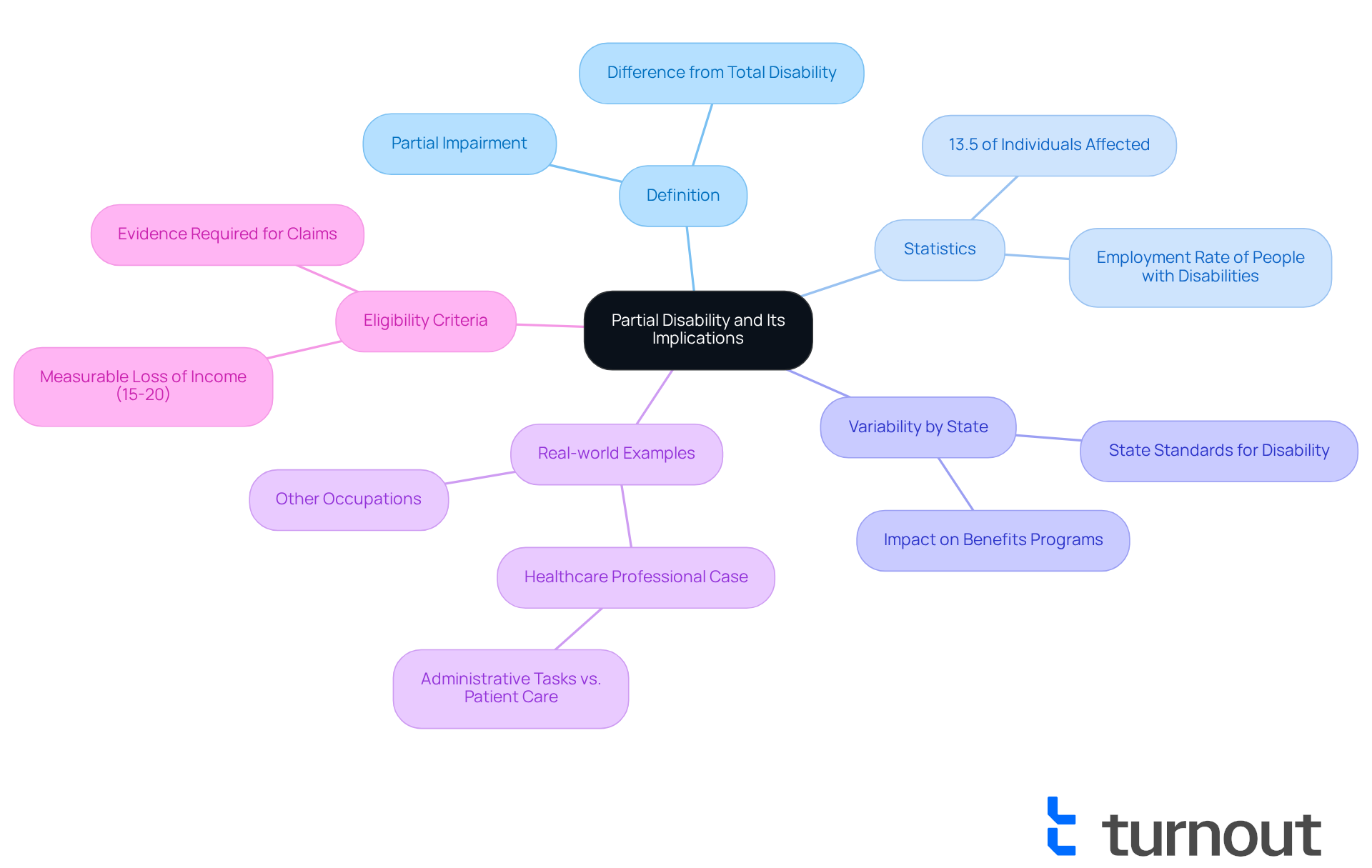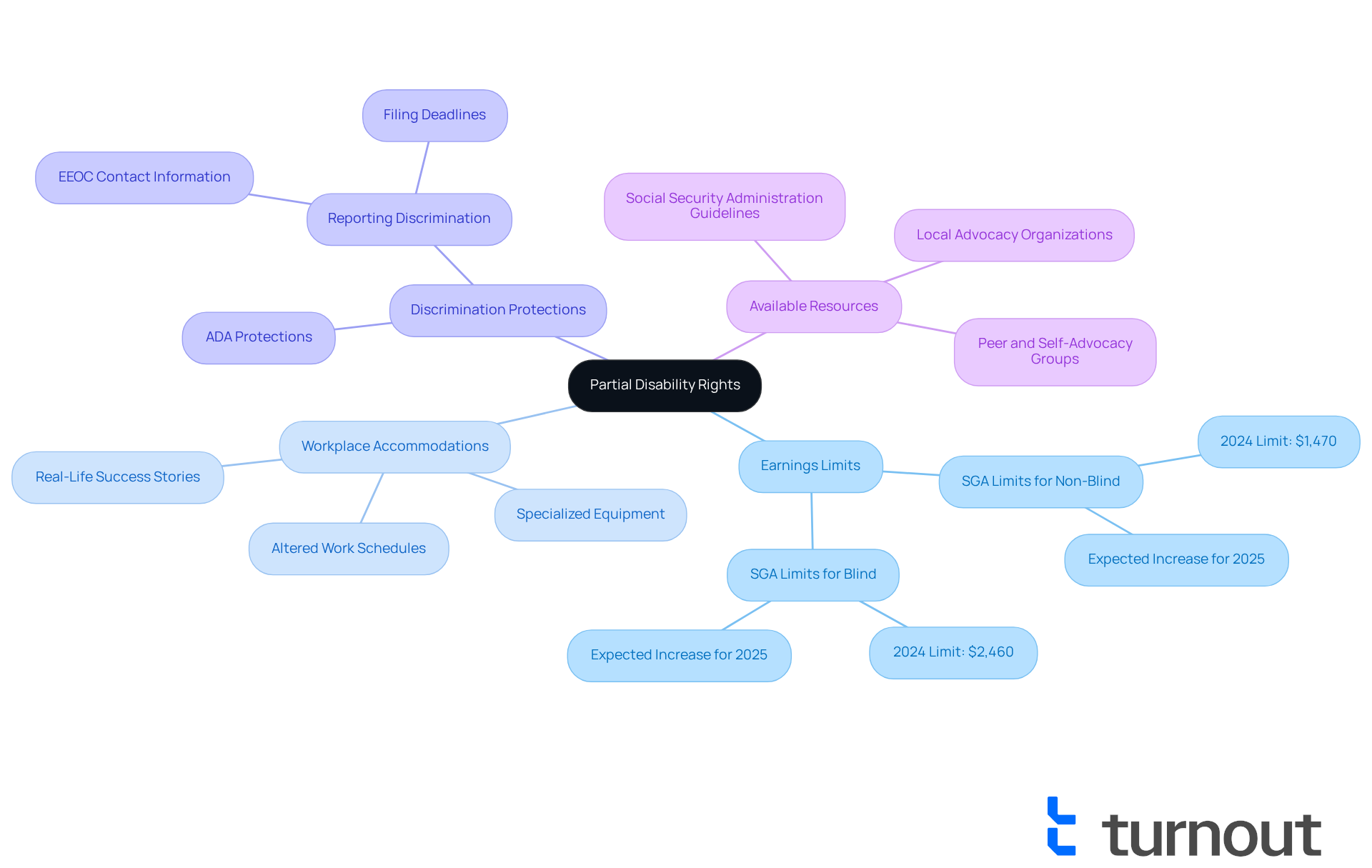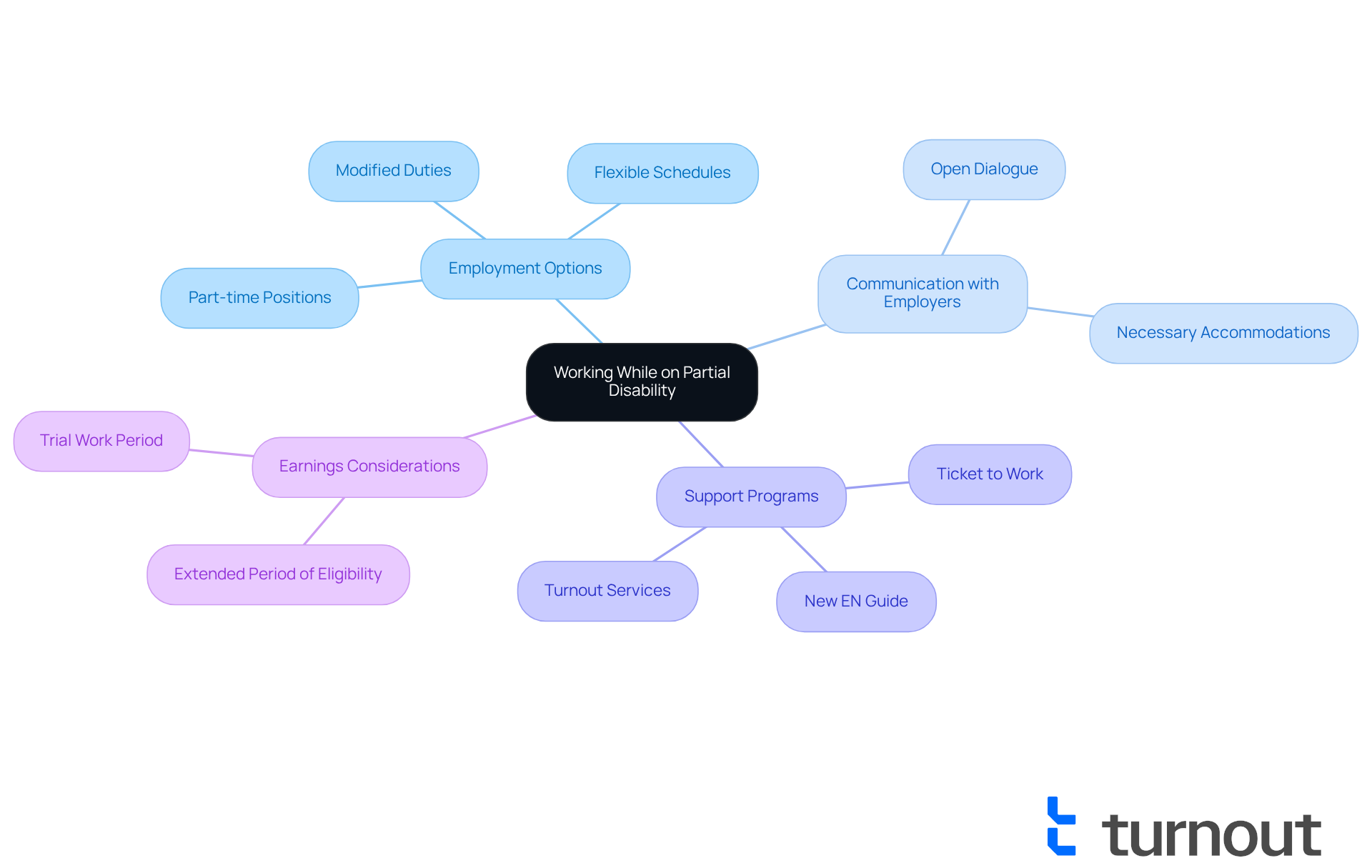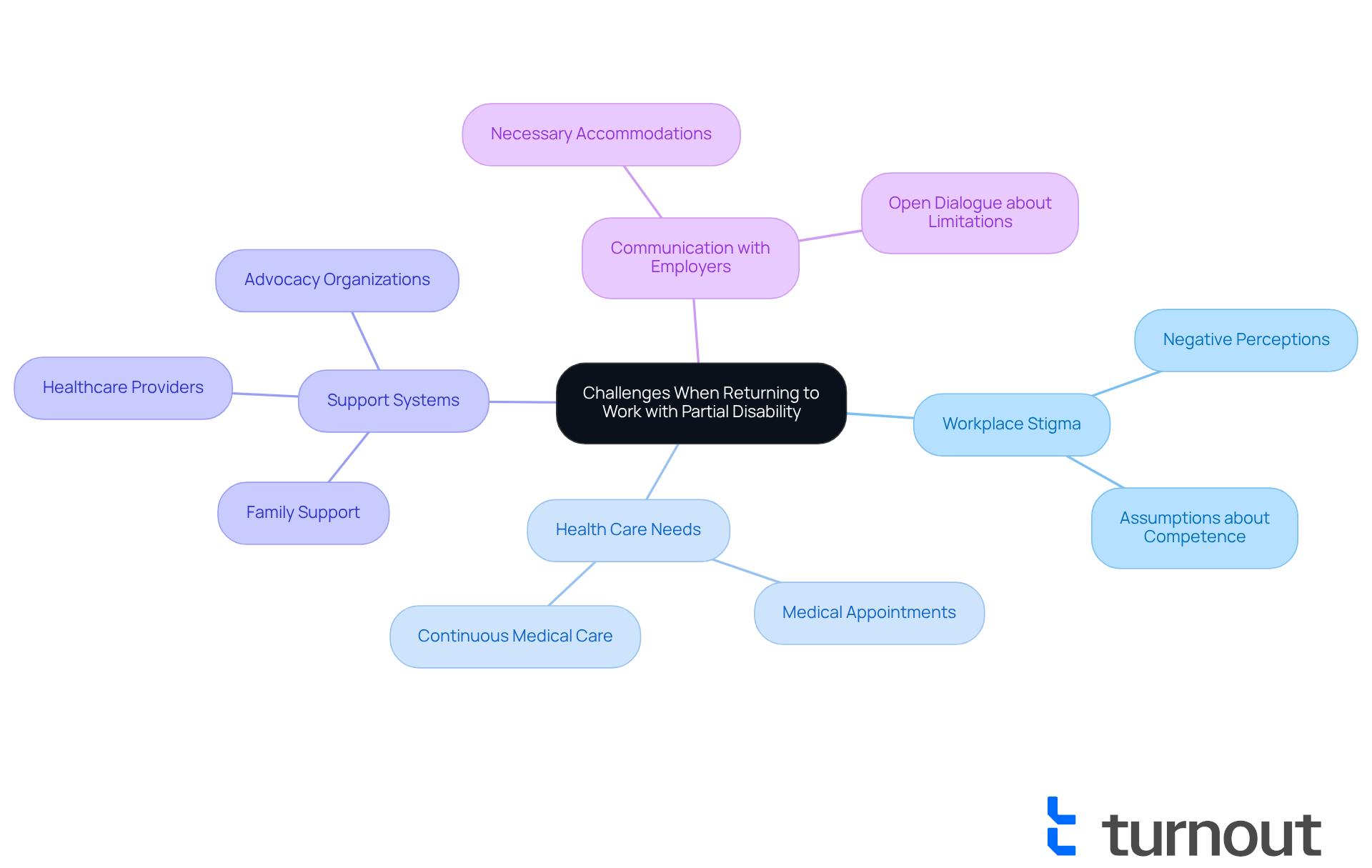Overview
Navigating the world of work while managing partial disabilities can be challenging. We understand that many individuals seek to maintain their livelihoods while receiving partial disability benefits. Fortunately, you can receive these benefits while still working, as long as your earnings do not exceed specific thresholds set by programs like Social Security Disability Insurance (SSDI).
Understanding the eligibility criteria, including the Substantial Gainful Activity (SGA) limit, is crucial. It’s common to feel overwhelmed by the details, but knowing your rights regarding workplace accommodations can make a significant difference. Remember, you are not alone in this journey; support is available to help you succeed in your employment options.
We encourage you to explore these opportunities and reach out for guidance. Together, we can navigate this path with compassion and understanding.
Introduction
Navigating the complexities of partial disability can feel overwhelming, especially for the estimated 13.5% of Americans living with some form of impairment. We understand that understanding the nuances of partial disability is essential, not only to determine eligibility for benefits but also to explore the possibility of maintaining employment. As individuals grapple with the question of whether they can receive partial disability while still working, it's common to face a myriad of challenges, from workplace stigma to the need for accommodations.
How can you effectively balance the pursuit of financial stability with the realities of a partial impairment? This guide delves into the intricacies of partial disability, offering insights and resources to empower you on your journey. Remember, you are not alone in this journey. We're here to help you navigate work while receiving the support you need.
Define Partial Disability and Its Implications
Partial impairment is a situation many face, where a person may struggle to perform certain job duties due to physical or mental limitations. This can stem from various factors, such as injuries, chronic illnesses, or mental health conditions. Understanding partial impairment is crucial, particularly to determine if can you get partial disability and still work. You might find that some individuals can still engage in part-time roles or adjusted responsibilities based on their unique limitations, leading to the question, can you get partial disability and still work?
In 2023, approximately 13.5% of non-institutionalized individuals in the U.S. were identified as having some form of impairment. This statistic highlights the prevalence of such conditions in the workforce. It's important to note that the standards for limited impairment can vary significantly by state and benefits program. Therefore, understanding the specific rules that apply to your situation is essential.
Real-world examples can illustrate how limited ability influences job responsibilities. For instance, a healthcare professional recovering from surgery may be capable of handling administrative tasks but unable to provide direct patient care. This nuanced understanding can empower individuals to navigate their options effectively and advocate for their rights.
Moreover, eligibility criteria for partial disability often raise the question of can you get partial disability and still work, as they typically require demonstrating a measurable loss of income, usually between 15% and 20%, due to the impairment. This means individuals must provide evidence of their limitations and how these affect their job capabilities. By grasping these concepts, you can better position yourself to receive the support you need while continuing to work within your capacity. Remember, you are not alone in this journey, and we’re here to help you every step of the way.

Understand Your Rights Under Partial Disability
Individuals with partial disabilities have specific rights under programs like Social Security Disability Insurance (SSDI) and Supplemental Security Income (SSI). You may not know that these rights allow you to work while still receiving benefits, which leads to the question: can you get partial disability and still work, provided your earnings don’t exceed certain thresholds, such as the Substantial Gainful Activity (SGA) limit? For 2024, the SGA limit is set at $1,470 per month for non-blind individuals and $2,460 for blind individuals. Slight increases are expected for 2025 to account for inflation.
We understand that navigating the workplace can be challenging. Many states have enacted regulations to protect employees from discrimination due to their condition. This ensures that you can seek necessary accommodations at work. Adjustments, such as altered work schedules or specialized equipment, can empower you to perform your job effectively. Real-life stories show that employees with partial impairments have successfully utilized these accommodations, allowing them to keep their jobs while receiving the support they need.
Comprehending these rights is vital, as they can significantly impact your ability to determine if you can get partial disability and still work while accessing essential benefits. Resources like the Social Security Administration's guidelines and local advocacy organizations are available to help you navigate these rights and stay updated on recent changes in discrimination regulations. Unfortunately, statistics reveal that workplace bias remains a significant issue, with many individuals facing obstacles due to their impairments. Staying informed about your rights and available resources empowers you to advocate for yourself and secure the support you deserve.

Explore Options for Working While on Partial Disability
If you're navigating the challenges of partial disability, you might wonder, can you get partial disability and still work, knowing that there are various employment options available that can accommodate your unique needs? Consider exploring part-time positions, flexible schedules, or modified duties that align with your abilities. We understand that communicating openly with employers about necessary accommodations—like adjusted hours or responsibilities—can be daunting, but it’s an important step in your journey.
Additionally, programs such as the Ticket to Work initiative are here to support you, offering valuable resources for those looking to transition back into the workforce. The New EN Guide for Working with Ticketholders and the YourTickettoWork.ssa.gov website can provide essential guidance as you navigate your options. Remember, Turnout also offers tools and services designed to empower you, including expert guidance to help you understand your rights and navigate the complexities of SSD claims and tax debt relief.
As you evaluate your employment choices, consider whether you can get partial disability and still work while keeping an eye on your earnings to ensure they remain within the permitted thresholds for your benefits. The Trial Work Period (TWP) allows you to assess your ability to engage in employment for at least 9 months while receiving full benefits. Following this, the Extended Period of Eligibility (EPE) enables you to continue receiving benefits as long as your earnings don’t exceed the Substantial Gainful Activity (SGA) threshold.
This proactive approach can help you maintain financial stability while pursuing fulfilling employment. By utilizing the resources available to you, including Turnout's expert guidance, you can successfully navigate the complexities of working while receiving disability benefits. Remember, you are not alone in this journey; we’re here to help you every step of the way.

Identify Challenges When Returning to Work with Partial Disability
Returning to a job with a partial impairment raises the question of how can you get partial disability and still work, which can indeed present various challenges that significantly impact your experience. We understand that physical limitations may hinder job performance, making it essential to assess how these constraints affect your daily tasks. Unfortunately, workplace stigma remains a pervasive issue, and many disabled employees face negative perceptions that can undermine their confidence and career progression. Research indicates that individuals with disabilities often encounter biases, leading to assumptions about their competence and reliability. It's disheartening to note that studies show disabled employees are frequently perceived as less capable, which can affect their interactions with colleagues and supervisors.
Moreover, the necessity for continuous medical care can interfere with your job hours, complicating the return to the workplace. As you navigate the challenges of balancing health requirements with job duties, you may wonder, can you get partial disability and still work, especially since adapting to altered roles or reduced hours can impact your self-worth and financial security? Developing a robust support system is crucial. This includes healthcare providers, family members, and advocacy organizations that can offer guidance and encouragement.
Open communication with your employers about your limitations and necessary accommodations is vital for facilitating a smoother reintegration into the workforce, particularly when discussing if you can get partial disability and still work. By proactively addressing these challenges and preparing for potential obstacles, you can enhance your chances of successfully returning to work and thriving in your role. Remember, you are not alone in this journey; we're here to help you every step of the way.

Conclusion
Navigating the complexities of partial disability while maintaining employment is a journey that requires understanding, advocacy, and support. We understand that individuals facing partial impairments can indeed work while receiving benefits, as long as they adhere to specific guidelines and thresholds. This balance allows them to contribute to the workforce and secure financial stability, proving that limitations do not have to define one's professional capabilities.
Key insights discussed include:
- Knowing your rights under programs like SSDI and SSI
- Exploring various options for flexible employment
- The significance of open communication with employers about necessary accommodations
Real-life examples demonstrate that many individuals successfully manage their roles while navigating the challenges posed by partial disabilities, highlighting the potential for empowerment and resilience in the face of adversity.
Ultimately, the message resonates: you are not alone in this journey. By understanding your rights, exploring available resources, and advocating for necessary support, you can thrive in your career. The path may be challenging, but embracing these opportunities can lead to fulfilling employment and a more inclusive workplace.
Frequently Asked Questions
What is partial disability?
Partial disability refers to a situation where an individual struggles to perform certain job duties due to physical or mental limitations resulting from injuries, chronic illnesses, or mental health conditions.
Can individuals with partial disability still work?
Yes, individuals with partial disability may still engage in part-time roles or adjusted responsibilities based on their unique limitations.
What percentage of individuals in the U.S. were identified as having some form of impairment in 2023?
In 2023, approximately 13.5% of non-institutionalized individuals in the U.S. were identified as having some form of impairment.
Do the standards for partial disability vary?
Yes, the standards for limited impairment can vary significantly by state and benefits program, making it essential to understand the specific rules that apply to your situation.
Can you provide an example of how partial disability affects job responsibilities?
A healthcare professional recovering from surgery may be capable of handling administrative tasks but unable to provide direct patient care, illustrating how limited ability influences job responsibilities.
What are the eligibility criteria for partial disability?
Eligibility for partial disability typically requires demonstrating a measurable loss of income, usually between 15% and 20%, due to the impairment, along with evidence of how these limitations affect job capabilities.




